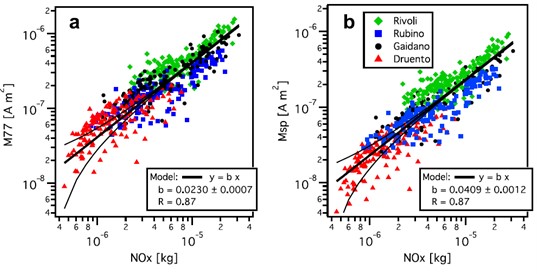Environmental magnetism
Magnetismo ambientale
Staff
- Zanella Elena (Manager)
- Tema Evdokia (Member)
Contacts
- +39 011 6708395
- elena.zanella@unito.it
- Website
- Send email to members

ERC Sectors
Activity
Environmental magnetism is a relatively recent application of rock magnetism techniques on the investigation of environmental issues related to atmospheric and soil pollution as well as to palaeonvironmental reconstructions and climate change. It investigates the magnetic properties of atmospheric particles, soils, marine and lacustrine sediments to establish correlations among magnetic concentration and atmospheric pollutants and to analyze possible influence of environmental conditions on the sediment’s deposition in various natural archives.
Airborne particulate matter pollution may cause important health problems both due to the very small dimensions and to the often-toxic chemical composition. Magnetic minerals are a common component of natural and anthropogenic air particles and their concentration, dimension and properties can offer information about their origin and possible correlation to high pollution levels. The magnetic properties can thus be used as a rapid, cheap, and usually non-destructive proxy for anthropogenically-induced pollution screening (Fig. 1).
Apart from pollution studies, environmental magnetism is also applied to the study of sedimentary sequences to reconstruct palaeoenvironmental, palaeoclimate and palaeoceanographic conditions based on the variation of magnetic properties in sedimentary cores.

Fig. 1 Correlation between the magnetic moments (M77 e Msp) and the concentration of nitrogen oxides (NOx) from various sampling sites around Torino (from Saragnese et al., 2011).
Dr. Enzo Ferrara, Istituto di Ricerca Metrologica, Torino, Italy Dr. Luca Lanci, Dipartimento di Fisica, Università di Urbino, Italy
Publications
Caron, B., Siani, G., Sulpizio, R., Zanchetta, G., Paterne, M., Santacroce, R., Tema, E., Zanella, E., (2012). Late Pleistocene to Holocene tephrostratigraphic record from the Northern Ionian Sea. Marine Geology, 311-314, 41-51. https://doi.org/10.1016/j.margeo.2012.04.001
Lanci, L., Zanella, E., Jovane, L., et al. (2019). Dataset of characteristic remanent magnetization and magnetic properties of early Pliocene sediments from IODP Site U1467 (Maldives platform). Data in Brief, 27, 104666. https://doi.org/10.1016/j.dib.2019.104666
Lanci, L., Zanella, E., Jovane, L., et al. (2019). Magnetic properties of early Pliocene sediments from IODP Site U1467 (Maldives platform) reveal changes in the monsoon system. Palaeogeography, Palaeoclimatology, Palaeoecology, 533, 109283. https://doi.org/10.1016/j.palaeo.2019.109283
Martinetto, E., Tema, E., Irace, A., Violanti, D., Ciuto, M., Zanella, E., (2018). High-diversity European palaeoflora favoured by early Pliocene warmth: New chronological constraints from the Ca′ Viettone section, NW Italy. Palaeogeography, Palaeoclimatology, Palaeocology, 496, 248-267. https://doi.org/10.1016/j.palaeo.2018.01.042
Saragnese, F., Lanci, L., Lanza, R., (2011). Nanometric-sized atmospheric particulate studied by magnetic analyses. Atmospheric Environment, 45, 450-459. https://doi.org/10.1016/j.atmosenv.2010.09.057
Tag: Minerali magnetici, particolato atmosferico, ricostruzioni paleoambientali





